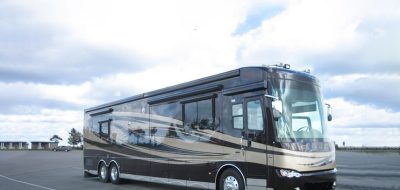Hi, folks,
As promised, some winterizing questions are addressed this month, along with a couple of general maintenance issues. Enjoy the crisp fall nights if you can: All too soon it will be winter! Send your RVing questions to [email protected]
——————————-
Mark:
I have purchased a 2013 Puma park model and have parked it on a friend’s farm in Granite Falls, NC. I spend most long weekends there and want to know if there are any special preparations I need to do over the winter. Sharon
Hi, Sharon,
A lot depends on how cold it gets in your area. If it only occasionally drops below freezing at night and warms up during the day, your park model will probably be fine as long as you have a source of dependable heat in it while you are gone. If it gets well below freezing, like down into the teens, or often stays below freezing for several days, it would be better to winterize it if you will only be using it occasionally during the winter. The first place to go for winterizing tips and procedures is the owner’s manual for your rig. After that, visit my website and read the articles on RV winterizing and surviving the winter that I wrote for Escapees magazine. www.marxrv.com/skp.htm . Finally, do a Google search on “winterizing the RV,” and you’ll turn up some excellent guides. Here are some of my favorites:
www.gonecamping.net/stories/winterize.html
http://rvservices.koa.com/rvinformation/rvmaintenance/step-by-step-rv-winterizing-checklist.asp
http://idiotsguides.com/static/quickguides/automotive/how-to-winterize-and-store-your-rv.html
http://www.camco.net/assets/catalog/winterizeRV.pdf
If you plan to use the RV after it is winterized, you will either need to dewinterize it for the period of use and then rewinterize it each time, or leave the fresh water system winterized and drink bottled water and minimize use of your plumbing system while you are using the RV.
———————————————
Dear Mark,
I have a question about winterizing our camper. My husband used the camper/marine antifreeze to winterize our camper last winter (2012). Due to an extremely busy work schedule this year, we were not able to use our camper. No, not even once. It is still winterized from last winter. My question is will our camper still be protected this year without changing the antifreeze? Will the antifreeze be deteriorated to the point of not protecting our water lines from freezing? Should we flush the system and start with fresh antifreeze for this current winter? I appreciate your time to answer these questions. Sincerely, Beverly
Hi, Beverly,
Since the antifreeze has been sealed in the RV’s plumbing system all year, it should not have degraded significantly. If it were my RV, I would leave it alone for the second year. However, you should add some additional antifreeze to the sink and tub drains, just in case, to help protect the drain traps. I hope you have been checking your batteries during this long storage period! Make sure the batteries have plenty of electrolyte in them, and, if needed, top them up with distilled water. Make sure they are fully charged, and keep them charged up: A discharged battery will freeze very easily. Check tire pressures and inflate any low tires to the proper pressure. Do a good visual inspection of the exterior, especially the roof, and check inside for any signs of leaks or pest infestations. You should be fine for another year, but be sure to drain and flush the water system next spring, and, hopefully, take the RV on some outings!
———————————————-
Hi, Mark,
We have a Winnebago class-C 28-ft. and need to cover it for the winter. We live near Seattle, WA. Can you recommend a covering material and manufacturer for us to order from? Thank you! Lorraine
Hi, Lorraine,
You can certainly use an RV cover when storing your rig. Just be sure to get a good quality cover that can be secured to the rig, and make sure it is constructed of breathable materials. A plain plastic tarp may do more harm than good if it allows moisture to build up underneath it! If you use a tarp, you must use wood spacers to lift the tarp off of the roof and sides to provide for some airflow under the tarp. This ventilation is needed to keep condensation or moisture from forming between the tarp and your RV. When shopping for a cover, look for the descriptive keyword “breathable.” This means that the cover will not be totally waterproof but will allow moisture that gets under the cover to evaporate. RV covers are available from Camping World and a number of online retailers. Check out rvcoversdirect.com. You can expect to pay $200 – $400 for a quality cover for your size RV, and I would be wary of “cheap” covers: Buy a name brand, like ADCO or Coverite, and it will serve you well. Be sure to attach it firmly to the RV with tie-downs as specified in the instructions. The cover should not be loose enough to flap in the wind, as that can damage painted surfaces.
—————————————————–
Mark:
For years we have read your articles on how to fix this thing or that, but, I admit, if I didn’t need it at the moment, well, I read with little enthusiasm. Now, two of my friends and I have the same big problem.
In order to prevent roof problems, we applied silicone caulking to all of the seams on our fiberglass roofs and over that used super-sticky tape. A big problem five years later, the tape trapped water, which leaked into our motorhomes and caused extensive damage in one of the MHs. Question: Is it a requirement to remove all of the silicone before we apply a new specially formulated sealer made by EPDM Coatings, which is liquid rubber? How do we most efficiently remove the silicone? Are heat guns in order? Sharp scrapers? Any advice is most appreciated. We took one of the MHs to an RV dealer/body shop for a cost estimate, but the $15,000 cost was too high in our minds.
Thank you, Big Mike
Hi, Big Mike,
Silicone is a very poor choice for repairing RV leaks. In my experience, it doesn’t bond reliably to most common RV exterior materials and is often applied to a surface that is less than squeaky-clean. Over time, parts of the silicone lose adhesion, and water starts seeping in. In order to properly repair your roof, you must first remove all traces of the silicone sealant, as most roofing repair materials will not stick to cured silicone. About the only way to remove the silicone is mechanically: It must be scraped off or otherwise removed by brute force. There are no solvents that will dissolve it, and heat is usually not very effective. On hard surfaces, you can use abrasives designed for paint removal, or just scrape at it till you get it all off. It will not be a fun job. Then, thoroughly clean the roof area where you expect to do the repair. On metal and fiberglass, acetone can be used as a final solvent to remove most contaminants. On a rubber roof, don’t use any solvents; instead, use a rubber-roof cleaning product or soapy water, and scrub thoroughly. Once the area is clean and dry, you can apply a self-leveling roof sealant or a roof repair product that is specifically designed for your roof material. It sounds like you already have an appropriate sealing product in mind, but here are some other options: Dicor makes a number of liquid roofing products for RVs (www.dicor.com). I have also had very good luck on my own RVs with Rapid Roof III (http://www.rvroofmn.com/product.htm ). If the surface is smooth and flat, you can use EternaBond repair tape (www.eternabond.com) to make a permanent repair. EternaBond has a high-tech adhesive that sticks like a bad relation to just about anything and makes a very long-lasting repair, but the surface needs to be flat and smooth. Good luck with your project!
—————————————-
Good afternoon, Mark:
I have a Viking pop-up camper. The trim on the top of the roof (inside) keeps coming down due to the heat buildup during storage. Is it possible to either glue or use very short nails on the trim? I don’t know how thick the roof is from inside to the top of the outside. The trim covers the seam in the middle of the ceiling. Thanks. Jeff.
Hi, Jeff,
I’d be a little leery about using nails on that trim strip, but a good construction adhesive, like Liquid Nails, available at home improvement stores, might do the trick. There are a bunch of different types of adhesive for various tasks, but the general-purpose Liquid Nails should be fine. You’ll need a caulking gun to apply it. Follow the directions on the tube to cut the nozzle and puncture the inner seal, if needed. Clean the trim strip and the area it covers to remove any loose material. Make sure there is something solid on both surfaces to glue to. Then, apply a bead of the adhesive to the trim and push it into place so that the adhesive spreads out and forms a good bond. Don’t use too much or it will ooze out at the sides. Press the trim into place until the adhesive “sets” enough to hold it. Hopefully, that will take care of it!
————————————————-
Hi, Mark,
I have a Rockwood 5th-wheel model 8244 s. I had trouble with the pump cycling at times. There were no leaks in the system. Changed the pump and the new one had the same problems. Just to let you know what the trouble turned out to be: The antifreeze connection has a valve it, and the line connects to a tee that connects the pump to the fresh water tank. This valve was leaking, causing the pump to start, and at times it could not pick up the prime and would just spin without even bringing the water up to pressure. If I opened any tap in the kitchen or bathroom, the pump would pressure the system up. I cut the antifreeze line and put a shut-off tap in the line to the tee. I have had no trouble after installing the shut-off tap. This might be some help to Lyn, as the same problem could be on their unit. Roy
Hi, Roy,
This may also help other RVers who are having issues with the water pump cycling or failing to shut off. Thanks for sharing!
Mark Nemeth has been involved with all things RV for more than 15 years, including almost five years on the road as a full-timer. He is the RV education director for Escapees RV Club and oversees the highly acclaimed RVers’ Boot Camp and SmartWeigh programs. Do you have a question for Mark? Please submit your question via email to [email protected].
Please remember, material will be edited. Because of the large volume of material and correspondence submitted, individual replies will be limited to questions that are chosen for publication.
Founded in 1978, the Escapees RV Club provides a total support network for RVers that includes a wide variety of opportunities for fun, adventure, and education.
MAIL SERVICE The best mail–forwarding service in the country. Members can personalize their mail delivery receiving only the mail they want when they want. MAGAZINE Award-winning magazine written for RVers by RVers.
CHAPTERS There are 51 chapters across the U.S., Canada, and Mexico that offer local luncheons and rallies within 150 miles of home.
HOPs Theme–related outings and adventures held across the country.
ESCAPADES Five–day educational events that offer over 60 seminars and workshops to educate, entertain, and enhance the RV lifestyle.
PARKS Our discount park system offers a variety parking options. PLUS MUCH MORE!
A complete listing of all Escapees events and a comprehensive list of member benefits are found at www.escapees.com.







Fernand Huet
Hi Mark
We have a Trail Runner and had problems with the water pump cycling. We couldn't find any leaks till one day I noticed a drip out of the hot water tank hatch, outside.
It turns out the pressure relief for the hot water tank would drip ever so slightly when the water heater was on, but not with the heater off. I replaced the pressure relief and the problem was solved.